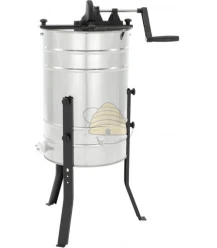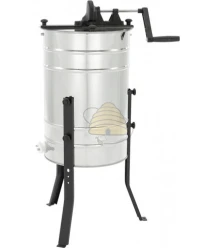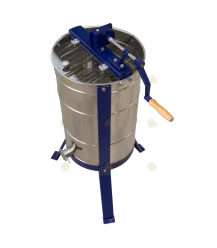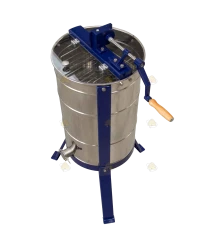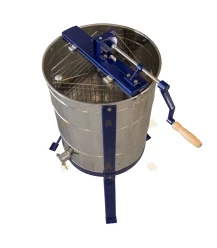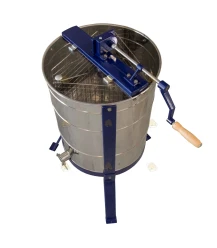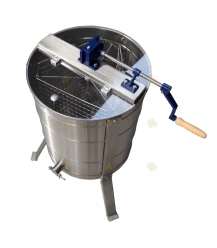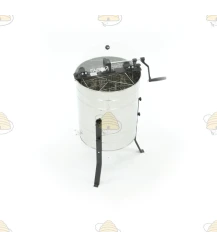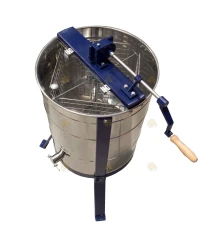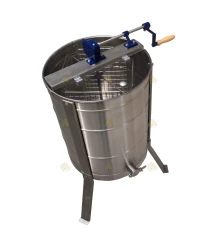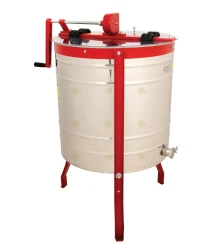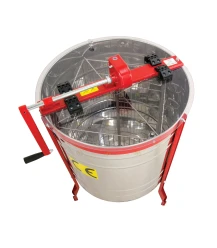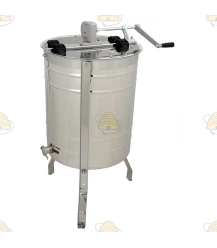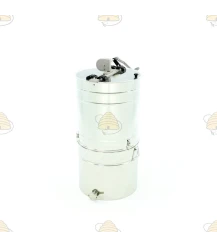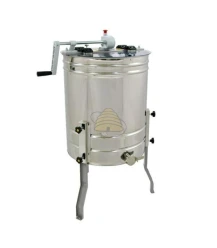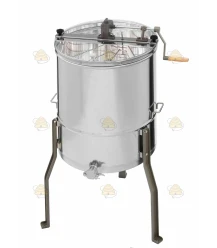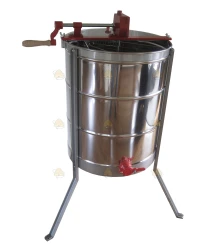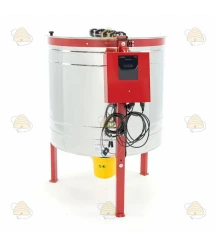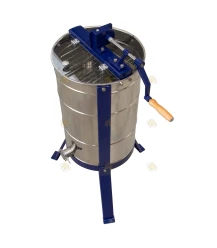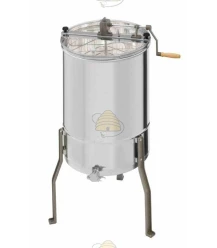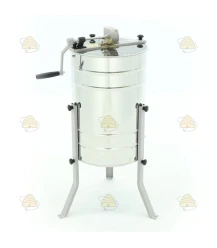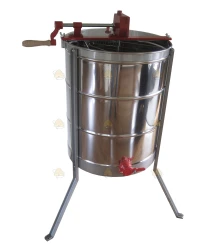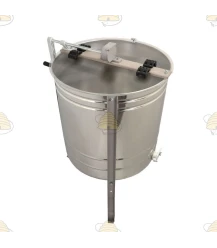Manual honey extractors
Buying a manual honey extractor can feel like a big step for a new beekeeper. Often you first learn the basics from a fellow beekeeper or a beekeeping association and can borrow their honey extractor or the association’s extractor. By purchasing your own honey extractor, you’ll work more efficiently: you no longer need to borrow, pick up, or return one.
There are honey extractors in different price ranges. You can start with a small extractor and later upgrade to a larger or more powerful model as your beekeeping operation grows.
-
Honey extractor protective cover - BeeFun®
€ 35,95 In stock and available for immediate delivery.Protective cover for a honey extractor with a maximum diameter of 520 mm. The cover is teardrop-shaped so the crank handle also fits underneath. With this cover you keep the extractor clean for the next extraction run!View more -
400 mm 3-frame tangential honey extractor (Basic)
€ 339,85 In Stock400 mm 3-frame tangential honey extractor. This manual honey extractor fits various hive frames such as Dadant, Langstroth, or simplex. This compact honey extractor is especially suitable for small-scale beekeepers who need to process a limited amount of honey. Technical specifications: Acid-resistant stainless steel Manual plastic crank 6/4" honey...View more -
400 mm 2-frame tangential honey extractor (Basic)
€ 308,95 In Stock400 mm 2-frame tangential honey extractor. This manual honey extractor is suitable for various types of hive frames such as Dadant, Langstroth or simplex. This compact honey extractor is especially suitable for small-scale beekeepers who need to process a limited amount of honey. Technical specifications: Acid-resistant stainless steel Manual plastic...View more -
420 mm 2-frame honey extractor BeeFun®
€ 411,95 Out of stockOut of stock420 mm 2-frame manual honey extractor by BeeFun. This honey extractor has a stainless steel drum with very sturdy blue-coated legs and a stainless steel honey gate. The basket inside the extractor has a fine mesh with no sharp edges and is suitable for hive frames up to a maximum size (excl. top bar) of 42 x 25 cm. The drum has a sloped bottom so no honey...View more -
400 mm 2-frame honey extractor with strainer + honey bucket with valve
€ 381,95 Out of stockOut of stock400 mm 2-frame stainless steel honey extractor, supplied with a strainer and honey tank. This extractor consists of 3 parts that can be separated using clamps. Suitable for hive frames up to 45 cm x 32 cm. The honey tank holds up to 50 kg of honey and is fitted with a plastic honey gate.View more -
520 mm 3-frame honey extractor BeeFun® plastic honey gate
€ 556,95 In stock and available for immediate delivery.520 mm 3-frame manual honey extractor from the BeeFun brand. This honey extractor has a stainless steel drum with very sturdy blue-coated legs and a plastic honey gate. The basket in the extractor has a small mesh size with no sharp edges and is suitable for frames up to a maximum size of 44 x 34 cm. The drum has a sloped bottom so no honey remains in the...View more -
520 mm 3-frame honey extractor BeeFun®
€ 571,95 In stock and available for immediate delivery.520 mm 3-frame manual honey extractor by BeeFun. This honey extractor features a stainless steel drum with very sturdy blue-coated legs and a stainless steel honey gate. The basket inside the extractor has a fine mesh with no sharp edges and is suitable for hive frames up to a maximum size of 44 x 34 cm. The drum has a sloped bottom so no honey is left...View more -
520 mm 3-frame honey extractor Premium BeeFun®
€ 621,95 In stock and available for immediate delivery.520 mm 3-frame manual honey extractor Premium by BeeFun. This honey extractor has a stainless steel drum with very sturdy stainless steel legs and a stainless steel honey gate. The basket inside the extractor has a fine mesh with no sharp edges and fits hive frames up to a maximum size of 44 x 34 cm. The drum has a sloped bottom so no honey remains in the...View more -
500 mm 4-frame honey extractor black
€ 645,95 In stock and available for immediate delivery.4-frame Basic honey extractor, made of stainless steel, with a sloped bottom for optimal honey drainage. The tank is fitted with a plastic honey gate. The extractor diameter is 50 cm and it can spin up to 4 brood frames at once (Simplex, Langstroth, Dadant and 8 Simplex honey super frames and/or 1/2 Dadant frames. The gears are metal. An excellent...View more -
520 mm 4-frame honey extractor BeeFun®
€ 707,95 In stock and available for immediate delivery.520 mm 4-frame manual honey extractor by BeeFun. This honey extractor has a stainless steel drum with very sturdy blue‑coated legs and a stainless steel honey gate. The basket inside the extractor has a small mesh with no sharp edges and fits frames up to a maximum size of 42 x 26 cm. The drum has a sloped bottom so no honey is left behind in the...View more -
520 mm 4-frame honey extractor Premium BeeFun®
€ 678,95 In stock and available for immediate delivery.520 mm 4-frame manual honey extractor Premium by BeeFun. This honey extractor has a stainless steel drum with very sturdy stainless steel legs and a stainless steel honey gate. The basket inside the extractor has a fine mesh with no sharp edges and is suitable for hive frames up to a maximum size of 45 x 26 cm. The drum has a sloped bottom so no honey is...View more -
500 mm 3-frame manual honey extractor (Deluxe)
€ 814,46 € 904,95 In stock and available for immediate delivery.Three-frame honey extractor, made of stainless steel, with a sloped bottom for optimal honey drainage. The drum is fitted with a stainless steel honey gate. This model has a hand brake and a 50 cm diameter. The extractor comes with metal gears and a comfortable plastic handle. An excellent extractor at a competitive price. This honey extractor is more...View more -
600 mm 4-frame manual honey extractor (Deluxe)
€ 908,95 In stock and available for immediate delivery.Four-frame honey extractor, made of stainless steel, with metal gears and a sloped bottom for optimal honey drainage. The drum is fitted with a stainless steel honey gate. This model includes a hand brake and has a diameter of 60 cm. The lid is made of 3 mm plastic (polycarbonate). An excellent extractor at a great price with a 2-year warranty! Made in...View more -
500 mm 3-frame manual honey extractor (Premium)
€ 926,96 € 1.029,95 In stock and available for immediate delivery.This 3-frame tangential premium manual honey extractor has a stainless steel drum with a sloped bottom. The drum diameter is 500 mm. The standout feature of this premium extractor is that almost everything is made of stainless steel. The frame basket is universal and suitable for simplex, Dadant, etc. This extractor comes with a 7-year warranty!View more -
500 mm 3-frame honey extractor with honey strainer and collection bucket (Easy)
€ 979,95 In stock and available for immediate delivery.Honey extractor 500 mm wide including strainer and stainless steel honey tank. For extracting 3 brood box frames or 6 honey super frames. The extractor has a width of 500 mm. In the underside of the extractor there are 4 openings through which the honey flows to the strainer. The strained honey is then collected in the ripener and /or the stainless steel...View more -
600 mm 4-frame shaftless honey extractor (Basic)
€ 572,95 In stock and available for immediate delivery.Four-frame Basic honey extractor, made of stainless steel, with a sloped bottom for optimal honey drainage. The drum is fitted with a plastic honey gate. The extractor is 60 cm in diameter and can spin 4 brood box hive frames at once or 8 honey super hive frames. This honey extractor has a shaftless design. Because there is no central shaft in the basket,...View more -
520 mm shaftless 4-frame honey extractor (Premium)
€ 999,95 In stock and available for immediate delivery.Robust honey extractor characterized by the absence of a central shaft. This makes it possible to spin larger hive frames without removing them from the basket. In addition, the drum is made of extra-thick stainless steel. The extractor comes with all the features you expect. It is supplied with legs and has a sturdy stainless steel honey gate. The...View more -
400 mm 3-frame honey extractor (Basic)
€ 504,95 In stock and available for immediate delivery.Compact quality honey extractor, on legs, for 3 brood frames or a tight 6 honey super frames. Suitable for the small-scale beekeeper with a few hives. Side drive with metal gears. Comparable to the Easy model but in 400 mm. Note: this extractor is supplied as a kit. This means the legs and the extractor arm, etc., still need to be assembled. Tip:...View more -
500 mm 4-frame manual honey extractor (Deluxe)
€ 970,95 In stock and available for immediate delivery.Honey extractor, 4-frame, made of stainless steel, with a sloped bottom for optimal honey drainage. The drum is fitted with a stainless steel honey gate. This model has a hand brake and a diameter of 50 cm. Suitable for 4 brood box (brood chamber) frames. 8 honey super frames will fit, but they must be loaded at the same time and carefully positioned...View more -
420 mm 2-frame honey extractor BeeFun® plastic honey gate
€ 381,95 Out of stockOut of stock420 mm 2-frame manual honey extractor by BeeFun. This honey extractor has a stainless steel drum with very sturdy blue-coated legs, a plastic honey gate, and a brake. The basket inside the extractor has a fine mesh with no sharp edges and fits hive frames up to a maximum size of 42 x 25 cm. The drum has a sloped bottom so no honey is left behind in the...View more -
520 mm 3-frame honey extractor (Deluxe)
€ 906,95 This product is ordered, delivery time is approximately 3-6 weeks.Heavy-duty honey extractor with an extra-thick stainless steel drum. The extractor is fully equipped with everything you expect from an extractor. It comes with legs and has a durable stainless steel honey gate. The extractor holds 3 brood box hive frames or 3 honey super hive frames, simplex size. The basket panel size is 37 (w) x 48 (h), which also...View more -
400 mm 2-frame honey extractor (Basic)
€ 391,95 Out of stockOut of stockSmall honey extractor on legs for extracting 2 hive frames (simplex, Dadant, German Normal, Langstroth). The extractor has a width of 400 mm, so it takes up little space. Made of acid-resistant stainless steel with a thickness of 0.5 mm. Supplied with a clear plexiglass lid. This extractor is equipped with a robust gear drive and is fitted with a plastic...View more -
500 mm 3-frame honey extractor (Basic)
€ 598,95 Out of stockOut of stockBasic 3-frame honey extractor, made of stainless steel, with a conical bottom for optimal honey drainage. The drum is fitted with a plastic honey gate. The extractor diameter is 50 cm and you can extract 3 brood frames at the same time (Simplex, Langstroth, Dadant and 6 Simplex honey super frames and/or 1/2 Dadant frames. The gears are metal. An excellent...View more -
500 mm 3-frame honey extractor (Easy)
€ 559,95 Out of stockOut of stockThree-frame Easy honey extractor, made of stainless steel, with a sloped bottom for optimal honey drainage. The drum is fitted with a stainless steel (INOX) honey gate. The extractor diameter is 50 cm and you can extract 3 brood frames at once or 6 honey super frames. All-metal gears. An excellent extractor at a great price and a 2-year warranty!...View more -
500 mm 3-frame honey extractor (Basic)
€ 656,95 Out of stockOut of stockThree-frame basic honey extractor, made of stainless steel and powder-coated components, with a sloped bottom for optimal honey drainage. The drum is fitted with a plastic honey gate. The extractor diameter is 50 cm and you can extract 3 brood box hive frames at once or 6 honey super frames. Good basic quality at a great price, with a 2-year warranty!...View more
What should you look for in a manual honey extractor?
With a manual honey extractor, it’s important to consider your needs. Price often correlates with quality. You’ll find different models with pricing based on size, finish, and sturdiness. Do you have just a few hives and want to extract a few times a year? Then you can often buy a good honey extractor on a small budget.
When you’re thinking about a honey extractor, the question often arises: do you want an electric honey extractor or a manual one? For a few hives, a manual honey extractor is usually sufficient. However, if you have 10 or 20 hives, the work becomes more intensive and family and friends are less willing to help. That may be the moment to switch to an electric honey extractor. Until then, a hand-crank honey extractor is often more than enough.
Different types of manual honey extractors
There are smaller models too, such as the tabletop extractor. This is a compact extractor for often two hive frames, instead of three as with a standard manual honey extractor on legs. The downside of a tabletop extractor is that you have to hold it during extracting, so you really need two people. With models on legs, you can place the extractor on the floor and stabilize it with your foot or even bolt it to the floor. A tabletop extractor is small and easy to store. Every extractor has its pros and cons.
Other types, such as radial honey extractors or cassette honey extractors, are often electric and more suitable for advanced beekeepers. If you plan to scale up, consider browsing this category.
The benefits of a manual honey extractor
A manual honey extractor is ideal for beginner and hobby beekeepers. It offers an affordable and efficient way to harvest honey without relying on expensive equipment. Thanks to simple operation, you have full control over the extraction, which is especially helpful with delicate honeycomb. Moreover, manual models are compact, durable, and easy to clean, making them a perfect fit for smaller apiaries. Because of the hand crank, you’re not dependent on electricity, which is useful in remote locations. In short, a manual honey extractor is a practical, cost-effective choice for any new beekeeper.
How does a manual honey extractor work?
A manual honey extractor is usually tangential. The hive frames sit parallel to the outer wall, and honey is flung out of the cells by centrifugal force. It’s important to extract in three steps:
- First, extract one side partially.
- Then fully extract the other side.
- Finally, extract the first side again to remove the remaining honey.
This prevents hive frames from breaking due to uneven honey distribution.
Tips for using a manual honey extractor
To get the most out of a manual honey extractor, keep the following in mind:
- Level position: Make sure the extractor is level to prevent movement from centrifugal force.
- Securing: Anchor the extractor firmly to the floor to prevent “walking.”
- Balance: Use an even number of frames for optimal stability.
- Floor protection: Place the extractor on rubber feet or a washable mat.
- Hygiene: Thoroughly clean the extractor and the extraction room before and after use.
How do I clean my manual honey extractor?
Cleaning the honey extractor is essential to ensure hygiene and extend its lifespan. There are two ways to do this: a simple rinse or disassembling the extractor. While disassembly allows thorough cleaning, both we and the manufacturer advise against it due to the complexity and risk of damage. Below, we explain the simple and effective step-by-step cleaning method.
Place the extractor preferably outside, near a drain, and clean it in the evening to prevent robbing by bees. Work quickly and use plenty of water so honey residues are rinsed away immediately. Have a clean bucket of soapy water, a sponge, and a biodegradable dish soap at hand.
Step-by-step cleaning plan
- Clean the exterior: Wipe down the outside of the honey extractor with soapy water. This prevents you from getting covered in honey during cleaning.
- Rinse the interior: Rinse the inside of the extractor thoroughly with cold water. Open the honey gate so water and honey residues can drain easily. If you are using an electric extractor, ensure no water enters the center to prevent motor damage.
- Clean with soap: Close the honey gate and let a shallow layer of cold water into the extractor. Add a small amount of biodegradable dish soap. Clean the inside of the drum with a soft sponge and, if needed, use a scouring pad for the basket. Do not use a scouring pad on the drum, as it can cause fine scratches.
- Rinse: Open the honey gate and rinse the extractor thoroughly with cold water. Check carefully that all beeswax and soap residues have been removed.
- Soapy water with warm water: Close the honey gate again and clean the extractor once more with soapy water, this time with warm water. This helps remove any remaining honey residues more easily.
- Thorough rinse and dry: Open the honey gate and give the honey extractor a final rinse with plenty of cold or warm water. Then dry it well with a clean towel to prevent rust.
Extra tips
- Clean the extractor immediately after use. Dried honey residues are much harder to remove.
- Use a soft cloth or sponge to protect metal parts from scratches.
- Ensure the extractor is completely dry before storage, especially if it won’t be used for a while. Also check out our protective covers.
With this method, your honey extractor stays clean, hygienic, and in top condition for your next honey harvest!
Alternatives
An alternative to a manual honey extractor is an electric honey extractor. It is often more expensive because it has a motor to ease the work. Tabletop extractors are cheaper but lack legs and are usually more compact.
Need help?
Do you have any questions? Feel free to contact us! You can call or email us; we’re ready with advice. On our website, you’ll find a wide range of honey extractors available for immediate online order.


